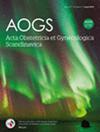Maternal postpartum infection risk following induction of labor: A Danish national cohort study
Abstract
Introduction
Induction of labor is a common procedure, and in Denmark, approximately one in four vaginal deliveries are induced. The association between induction and maternal postpartum infections such as endometritis, surgical site infection after cesarean section, urinary tract infection, and sepsis has been sparsely investigated. Our objective was to investigate the association between induction of labor and risk of maternal postpartum infection and to identify potential risk factors for infection.
Material and Methods
In a nationwide cohort study, all deliveries with live-born singletons from January 1, 2007, to December 31, 2017 (n = 546 864) were included. Deliveries were grouped into categories of spontaneous onset of labor, induction of labor, and elective cesarean section. The primary outcome was any infection within 30 days postpartum based on discharge diagnosis codes and redeemed antibiotic prescriptions for endometritis, surgical site infection, urinary tract infection, and sepsis. Analyses were done using logistic regression.
Results
Infection within 30 days postpartum was found among 8.5% of the women undergoing induction of labor compared to 6.8% of the women with spontaneous onset of labor. In adjusted logistic regression analyses, the risk of postpartum infection was significantly increased after induction of labor compared to spontaneous onset of labor (adjusted ORs [aOR], 1.24; 95% confidence interval [CI], 1.21–1.27). Women with rupture of membranes were not at increased risk of postpartum infection (aOR 1.01; 95%CI 0.94–1.09). The risk of postpartum maternal sepsis was not significantly associated with induction of labor. Antibiotic treatment during pregnancy, pre-eclampsia, and long education were all associated with increased risk of maternal postpartum infection, while either a low or high body mass index and previous deliveries were associated with decreased risk.
Conclusions
Induction of labor was associated with an increased risk of maternal postpartum infection. However, the absolute risk was 1.7% higher for the women with induced labor compared to spontaneous onset of labor, which we believe should not be a cause for concern. Unexpectedly, low and high body mass index was associated with decreased risk of infection, and rupture of membranes was not associated with increased risk after induction of labor, which might reflect actual clinical management.


 求助内容:
求助内容: 应助结果提醒方式:
应助结果提醒方式:


